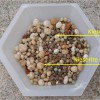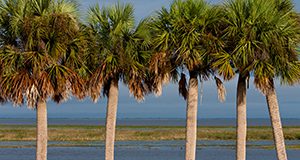Palms growing in Florida landscape or field nurseries are subject to a number of potentially serious nutrient deficiencies. This five-page document discusses the prevention and treatment of these deficiencies. Written by Timothy K. Broschat and published by the Environmental Horticulture Department.
http://edis.ifas.ufl.edu/ep261
Tag: Palm Nutrition and Fertilization
Not All Landscape Palm Fertilizers Are Created Equal
 Palms are widely planted in Florida landscapes. Their bold leaf textures create a tropical or Mediterranean look that is highly desired by residents and tourists alike. But palms have very high nutritional requirements, and deficiencies of any element can result in conspicuous and unattractive symptoms on their large leaves. UF/IFAS research shows that the most effective fertilizer has 100% of the N, K, Mg, and B sources in slow-release or controlled-release form and that all of the Mn, Fe, Zn, and Cu sources should be water soluble. This 4-page fact sheet explains the reasons for this recommendation and how to ensure that you have a formulation that will be effective. Written by Timothy K. Broschat, and published by the UF Department of Environmental Horticulture, March 2015. (Photo Credit: T.K. Broschat)
Palms are widely planted in Florida landscapes. Their bold leaf textures create a tropical or Mediterranean look that is highly desired by residents and tourists alike. But palms have very high nutritional requirements, and deficiencies of any element can result in conspicuous and unattractive symptoms on their large leaves. UF/IFAS research shows that the most effective fertilizer has 100% of the N, K, Mg, and B sources in slow-release or controlled-release form and that all of the Mn, Fe, Zn, and Cu sources should be water soluble. This 4-page fact sheet explains the reasons for this recommendation and how to ensure that you have a formulation that will be effective. Written by Timothy K. Broschat, and published by the UF Department of Environmental Horticulture, March 2015. (Photo Credit: T.K. Broschat)
http://edis.ifas.ufl.edu/ep516
Boron Deficiency in Palms (ENH1012/EP264)
 Chronic boron deficiency is believed to be caused by soil drying and high soil pH, while temporary deficiency is caused by heavy leaching. It results in a wide array of symptoms, not only among species of palms, but also within a single species. This 5-page fact sheet contains many illustrations to aid in diagnosis and management recommendations. Written by Timothy K. Broschat and published by the UF Department of Environmental Horticulture, June 2011.
Chronic boron deficiency is believed to be caused by soil drying and high soil pH, while temporary deficiency is caused by heavy leaching. It results in a wide array of symptoms, not only among species of palms, but also within a single species. This 5-page fact sheet contains many illustrations to aid in diagnosis and management recommendations. Written by Timothy K. Broschat and published by the UF Department of Environmental Horticulture, June 2011.
http://edis.ifas.ufl.edu/ep264
